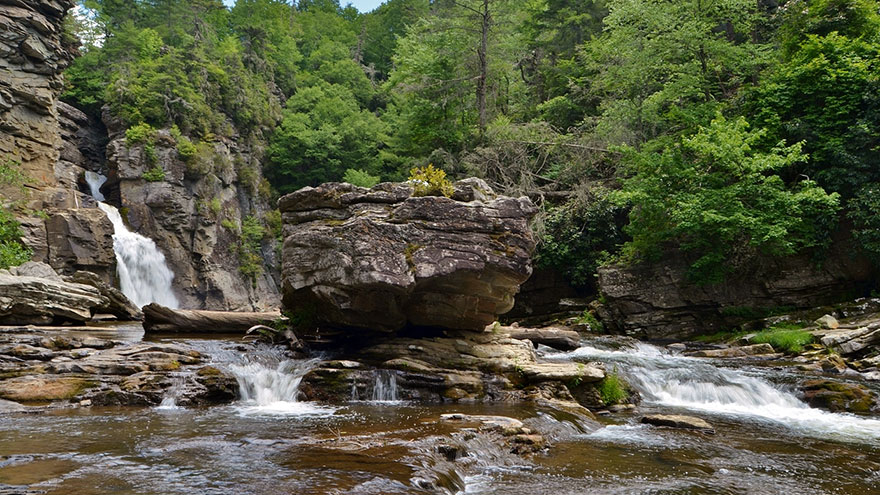Camping on Cabin Trail in Linville Gorge, NC
Set in the mountains of western North Carolina, the 12,000-acre Linville Gorge Wilderness is part of Pisgah National Forest and sometimes called the “Grand Canyon of the East.” The rugged gorge, formed by the Linville River and bordered by Jonas Ridge and Linville Mountain, provides visitors with scenic views of forested slopes, waterfalls and the namesake river.
Recreational opportunities such as rock climbing, hunting, fishing and 39 miles of hiking trails abound in the wilderness area. Although no developed campgrounds are in the Linville Gorge Wilderness, camping is allowed for backpackers, including those hiking the Cabin Trail.

About the Trail
At only 0.75 miles, the Cabin Trail, which starts along Linville Gorge’s western rim, is the shortest trail in the Linville Gorge Wilderness, but don’t let that fool you. It is an extremely steep and rugged path that starts near the former site of an old hunting cabin and leads to the Linville River at the bottom of the gorge.
In its short distance, the trail drops approximately 1,000 feet in elevation before connecting with the Linville Gorge Trail, which winds along the river. Fall is one of the better times to hike the trail, when temperatures are cool and the surrounding forests explode in vibrant reds, oranges and yellows.
Trailheads and parking areas for the western-rim trails, including the Cabin Trail, lie just off N.C. 1238/Kistler Memorial Highway.
Camping Along the Trail
Backpacking and wilderness camping is allowed along the Cabin Trail and most other western-rim trails, although free permits are required on weekends and holidays only from May to October. Permits can be obtained from the Grandfather Ranger District office by mail or in person.
Camping is not allowed within 200 feet of trails, and campers are asked to minimize their impact on the wilderness area by avoiding overused areas and campsites, picking up litter, packing out all garbage and burying human waste at least 6 inches deep.
Use existing fire rings or backpacker stoves if possible; if you must build a fire, keep it small and drown it thoroughly when finished. Remove evidence of all areas cleared for a fire or sleeping by replacing or scattering sticks and leaves.
RELATED :: Camping Near the Bay of Fundy
Cautions and Considerations
Because the Cabin Trail is so steep, hikers should wear high-ankle hiking boots, use caution and go slowly so as not to twist an ankle. Some wilderness trails are not well marked or maintained, so it is a good idea to have a compass and an official map of the area before setting out on your journey.
All hikers in the Linville Gorge Wilderness should be able to identify and keep an eye out for copperheads and timber rattlers, two poisonous snakes native to the area. Bear, deer and raccoons also are present in the wilderness, so backpackers should store all trash and food in sealed containers away from their campsites and never leave food unattended.
Nearby Trails and Camping
Several other trails are set along the Kistler Memorial Highway on Linville Gorge’s western rim, many of them connecting to the 11.5-mile Linville River Trail that winds along the river at the bottom of the gorge. One of the most popular is the Linville Falls Trail, which provides several overlooks of the waterfall’s upper and lower tiers.
In addition, an 11-mile section of North Carolina’s Mountains-to-Sea Trail, a nearly 1,000-mile trail that stretches from the Great Smoky Mountains to the Outer Banks, passes along the gorge’s western rim. For campers who prefer developed campsites, Mortimer Campground is the closest to the Linville Gorge Wilderness.
The campground, open from April to November, includes sites for tents and RVs, plus drinking water, restrooms, showers and a picnic shelter.
You Might Also Like :: Grand Teton and Backcountry Camping

